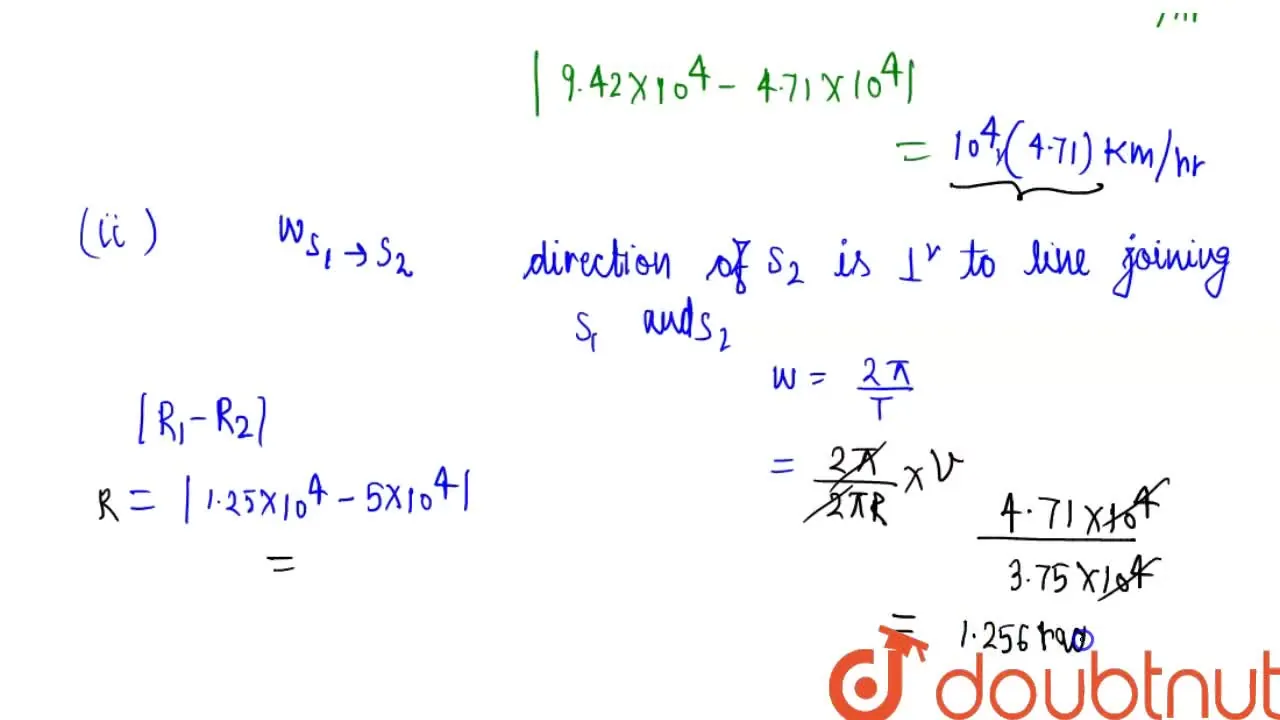S1 and S2 are two satellites revolving around a planet P in coplanar circular orbits in anticlockwise direction. Their period of revolution are 50 minutes and 400 minutes respectively. The radius of orbit of S2 is 5×104km.
(a) Find the radius of orbit of S1
(b) When S2 is closest to S1, then find (i) speed of S1 relative to S2 and (ii) angular speed of S1 as observed by astronaut in S2.
Let m1 and m2 be masses of satellites M is the mass of planet.
Radius of S2 is R2=5×104km
Radius of S1 is R1=?
V1 and V2 are linear speeds of satellites w.r.t. planets P as shown in figure.

(a) According to Kepler.s law the square of time period of planet revolution is directly proportional to the cube of semi-major axis of elliptical path.
∴(T1T2)2=(R1R2)3
(R2R1)3=(T1T2)2=(40050)2
(R2R1)3=64
⇒(R2R1)3=(4)3
R2R1=4
R1=R24=5×1044km
=1.25×104km
R1=1.25×104km
(b) V1=2πR1T1=2×3.14×1.25×104×6050
=9.42×104km/h
V2=2πR2T2=2×3.14×5×104×60400
=4.71×104km/h
(i) When S2 is closest to S1 and both are moving in same direction, then speed of S1 relative to S2.
V12=|V1−V2|=|9.42−4.71|×104
=4.71×104km/h
(ii) Let ω be the angular speed of S1 observed by an astronaut in S2. When seen from satellite S2, the satellite S1 is at a distance of R=R1−R2=∣∣1.25×104−5×104∣∣
=3.75×104km at closest separation.
The direction of motion of S2 is perpendicular to the line joining both of them.
Therefore, angular speed of S1 as observed by an astronaut in S2 will be
ω=2πT=2π2πR/V
ω=4.71×1043.75×104
=1.256×104rad h−1
Related Playlists
- BOOK - MODERN PUBLICATIONCHAPTER - GRAVITATIONEXERCISE - NCERT FILE (TEXTBOOK EXERCISES)23videos
GRAVITATION
- BOOK - MODERN PUBLICATIONCHAPTER - GRAVITATIONEXERCISE - NCERT FILE (Additional Exercises)4videos
GRAVITATION
- BOOK - MODERN PUBLICATIONCHAPTER - GRAVITATIONEXERCISE - Conceptual Questions19videos
GRAVITATION
- BOOK - MODERN PUBLICATIONCHAPTER - MATHEMATICAL TOOLSEXERCISE - PRACTICE PROBLEMS (10)12videos
MATHEMATICAL TOOLS
Similar Questions
Two satellites S1 and S2 revolve round a planet in coplanar circular orbits in the same sense. TI1eir periods of revolution are 2 hours and 16 hours respectively. If the radius of the orbit of S1 is 104, then the radius of the orbit of S2 is
View SolutionTwo satellites S1 and S2 resolve round a planet in coplaner circular orbit in the same sense. Their period of revolution are 1 hour and 8 hour respectively. The radius of the orbit of S1 is 104km. When S2 is closest to S1, find
(a) The speed of S2 relative to S1,
(b) The angular speed of S2 actually observed by an astronaut is S1View SolutionTwo satellites S1 and S2 revolve around a planet in coplanar circular orbits in the same sense their periods of revolution are 1 hour and 8hours respectively the radius of the orbit of S1 is 104 km when S1 is closest to S2 the angular speed of S2 as observed by an astronaut in S1 is :
View SolutionTwo satellite S1andS2 revolve round a planet in coplanar circular orbits in the same sense. Their periods of revolution are 1hr and 8hours respectively. The radius of the orbit of S1is104km. When S2 is closet to S1 (i) the speed S2 relative to S1 as actually observed by an astronaut in S1.
View SolutionTwo saetllites S1 and S2 revolve around a planet in coplaner circular orbit in the same sense. Their periods of revolutions are 1 hour and 8 hours respectively. The radius of orbit of S1 is 104km. When S2 is closed to S1, the speed of S2 relative to S1 is π×10nkm/h. what is the value of n?
View SolutionTwo stallites A and B revolve round the same planet in coplanar circular orbits lying in the same plane. Their periods of revolutions are 1h and 8h, respectively. The radius of the orbit of A is 104km. The speed of B relative to A when they are closed in kmh−1 is
View SolutionTwo satellites S1andS2 revole round a planet in coplanar circular orbits in the same sanse. Their periods of revolution are 1 hour and 8 hour respectively. The radius of the orbit of S1is104km, When S2isclosest→S1 find
(i) the speed of S2relative→S_1<br>(ii)theanga––rspeedofS_2asactuallyobservedbyan∗ronautisS_1.View SolutionTwo satellites S1 and S2 revolve round a planet in the same direction in circular orbits. Their periods of revolutions are 1 hour and 8 hour respectively. The radius of S1 is 104 km. The velocity of S2 with respect to S1 will be -
View SolutionTwo satellite S1andS2 revolve roudna planet in coplanar circular orbits in the same sense. Their periods of revoltions are 1 h nd 8 h respectively. tE radius of the orbit of S1 is 104km. When S2 is closet to S1., find as. The speed of S2 relative to S1 and b. the angular speed of S2 as observed by an astronaut in S1.
View SolutionTwo satellites revolve around a planet in coplanar circular orbits in anticlockwise direction. Their period of revolutions are 1 hour and 8 hours respectively. The radius of the orbit of nearer satellite is 2×103 km. The angular speed of the farther satellite as observed from the nearer satellite at the instant when both the satellites are closest is πx rad h−1 where x is ________.
View Solution


